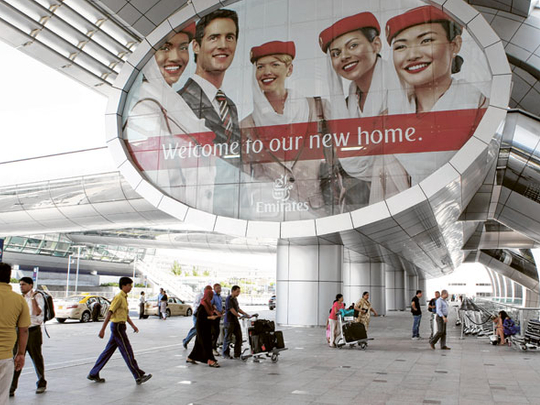
Dubai: The International Air Transport Association (IATA) forecasts a fall in profitability for carriers in the Mena region as capacity expansion outstrips demand while planes are fighting for airspace.
The region's carriers are doing well financially with IATA expecting $400 million (Dh1.4 billion) profits this year opposed to losses last year.
"A more cautious approach to capacity is helping to drive this improvement. While demand is in line for a 21 per cent increase over last year, the capacity increase has been limited to 15.9 per cent," Giovanni Bisignani, IATA's Director General and CEO, told the Arab Air Carriers Organisation (AACO) annual general meeting in Cairo.
Globally, IATA expects a fall in profitability next year to $5.3 billion from the $8.9 billion that airlines are expected to make in 2010.
On trend
Mena carriers are expected to follow that trend with a reduction in profit by $100 million from 2010 driven by an expected capacity expansion of 10.6 per cent outstripping demand growth of 10.4 per cent. "There won't be an oversupply of capacity, but demand will outstrip supply within five years," aviation analyst Saj Ahmad, told Gulf News.
He explained that most of the capacity growth hasn't been seen yet. Part of the orderbook is to replace old aircraft with new ones.
"Even when for example Al Maktoum International Airport in Dubai comes on-line it may look like there is excess capacity, but airlines will move from Dubai International to Al Maktoum. In reality it is simply under-utilised capacity," he added.
The Mena region's aviation industry and governments are planning to expand its airports, including eight new runways in the Gulf at a cost of $100 billion, according to IATA.
"Over the last decade, the carriers of the Middle East and North Africa have grown from 5 per cent of global traffic to 11 per cent," Bisignani said.
Planned aircraft purchases of $200 billion over the next decade will support this growth into the foreseeable future, he added, warning this expanding global presence brings with it the challenge of playing a larger role in the global aviation community.
Although infrastructure investments support the economic benefits of aviation's growth, said Bisignani, what is being built and planned on the ground is not being matched in the air. "What is being built and military airspace covers 60 per cent of the region, limiting capacity and forcing inefficient routing. We must cooperate to open more of the region's skies," said Bisignani.
However, Ahmad thinks the region will adapt its airspace allocation to accommodate rising commercial traffic. Taking the UAE as an example where air travel is still developing, he told Gulf News there will be a change from military airspace taking precedence to commercial airspace.
"The UAE will be, for example, able to free up airspace for commercial operations via sharing airspace allocated to military exercises with that allocated to the US or Europe. There always is excess airspace available as buffer zones for emergencies," he said.
Accidents
IATA also reported the region's hull loss rate for Western built aircraft slipped from zero accidents in 2006 to 3.32 accidents per million flights in 2009, a statistic which concerned Bisignani.
"At 4.6 times the global average of 0.71, that is a concern. The region's rapid growth must be accompanied with a strong safety record," he said challenging Mena's governments, which haven't adopted IATA's two safety audits, to do so as part of national requirements.
"Statistics look worse when one looks at a spike in aircraft accident numbers in isolation. It is not a reflection of a trend. One has to see it in relation to the growth in air travel. Dubai's response to the recent UPS carrier crash was phenomenally efficient," Ahmad said. "Yes, there may be an issue with older jets in some countries where they find it is expensive or not easy to get hold of spare parts, such as Syria, Iraq and Iran under sanctions, thus compromising safety," he added.
Dubai Dubai Airports announced its September traffic results for Dubai International today reporting a 25 per cent surge in year-on-year passenger numbers and an 11.3 per cent rise in international freight volumes.
For the second consecutive month passenger numbers fell just short of the four million mark at 3,988,804 up 25 per cent compared to the same period last year when 3,190,408 passengers passed through the facility.
Year to date passenger traffic is up 15.8 per cent as 34,838,359 million passengers have passed through Dubai International compared to 30,091,431 during the corresponding period last year.
The largest increases in total passenger numbers in September were recorded on routes to and from Western Europe (+149,510 passengers), the Indian subcontinent (+148,329 passengers), AGCC countries (+140,974) and Africa (+84,317 passengers). The largest percentage passenger traffic growth was seen on routes to and from Eastern Europe (247 per cent), AGCC countries (36 per cent), Asia and Asia Pacific (33 per cent), Africa (25 per cent) and Western Europe (23 per cent).
Cargo volumes saw double-digit growth for the twelfth consecutive month as September traffic rose 11.3 per cent to 187,390 tonnes compared to 168,335 tonnes recorded during the same period last year.
Volumes for both exports and transit freight volumes rose during the period while imports were down slightly.
Year to date cargo volumes total 1,685,634 tonnes compared to 1,366,881 tonnes during the same period in 2009, up 24 per cent.











